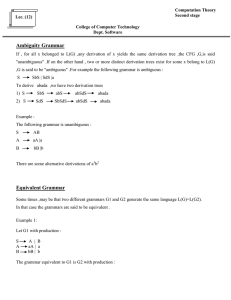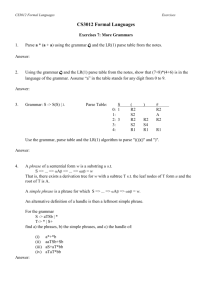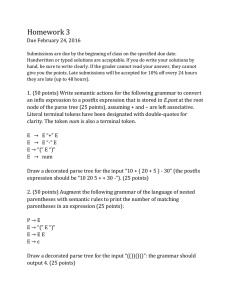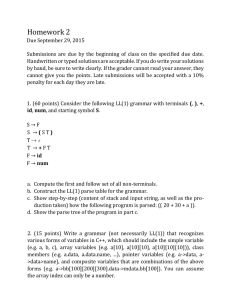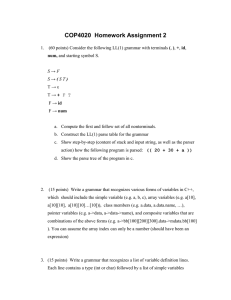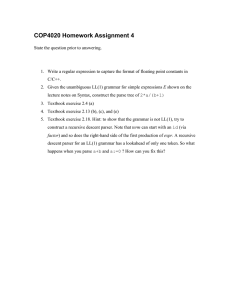A Context- Free Grammar (CFG) G is a 4-tuple (N, ,R,S), nonterminals
advertisement
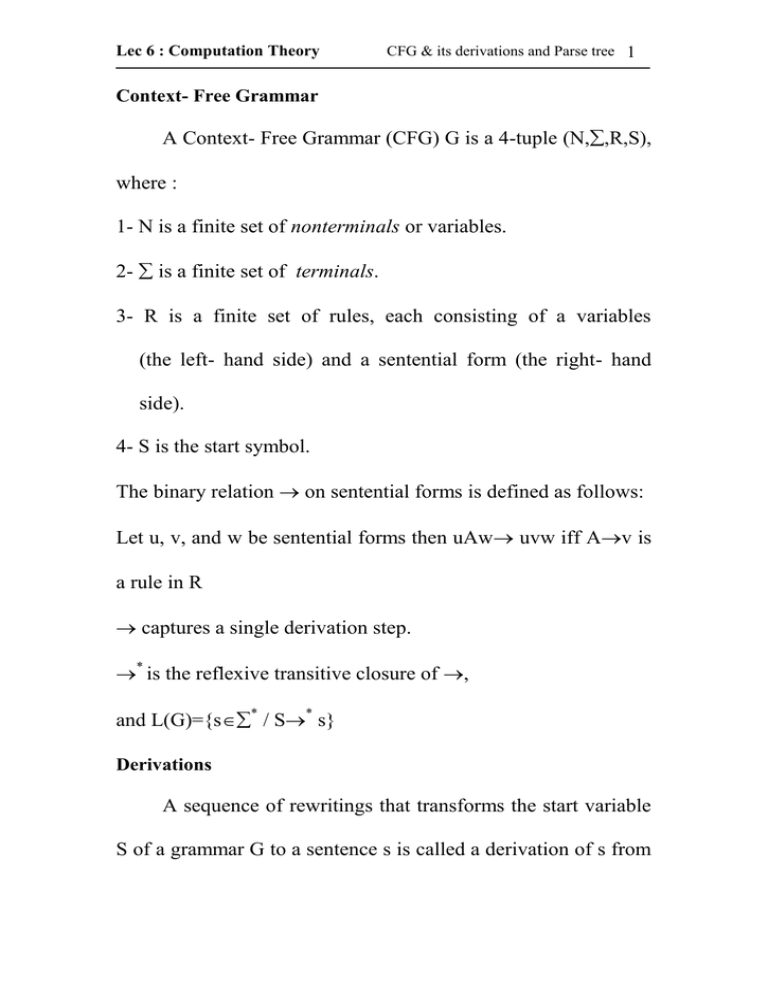
Lec 6 : Computation Theory
CFG & its derivations and Parse tree 1
Context- Free Grammar
A Context- Free Grammar (CFG) G is a 4-tuple (N,,R,S),
where :
1- N is a finite set of nonterminals or variables.
2- is a finite set of terminals.
3- R is a finite set of rules, each consisting of a variables
(the left- hand side) and a sentential form (the right- hand
side).
4- S is the start symbol.
The binary relation on sentential forms is defined as follows:
Let u, v, and w be sentential forms then uAw uvw iff Av is
a rule in R
captures a single derivation step.
* is the reflexive transitive closure of ,
and L(G)={s* / S* s}
Derivations
A sequence of rewritings that transforms the start variable
S of a grammar G to a sentence s is called a derivation of s from
Lec 6 : Computation Theory
CFG & its derivations and Parse tree 2
G. A derivation in which every derivation step uses the left most
variable in the sentential form is called a left most derivation.
A grammar G is called ambiguous if there exist a string s
with tow different left most derivations from G.
For example: the arithmetic expression grammar
E0\1…..\9\(E)\E*E\E+E
Is ambiguous because the sentence
2+3*4
Has tow different left most derivations
EE*EE+E*E2+E*E2+3*E2+3*4
EE+E2+E2+E*E2+3*E2+3*4
Pars trees
Here is another grammar for arithmetic expressions:
ET|T+E
TF|F*T
F0|1|…|9|(E)
When the start variable is unspecified, it is assumed to be the
variable of the first rule in this case E.
This grammar is unambiguous (convince yourself of this fact)
Lec 6 : Computation Theory
CFG & its derivations and Parse tree 3
Here is the parse tree for (3+7)*2
E
T
F
*
(
)
E
T
F
+
F
T
E
T
2
F
3
7
This is only parse tree for this sentence (using this grammar).
In contrast, consider the previous grammar
E0|1|…|9|(E)|E*E|E+E
This grammar has two different parse trees for the sentence
3+7*2.
Lec 6 : Computation Theory
CFG & its derivations and Parse tree 4
E
E
+
E
3
E
E
*
2
7
E
E
*
E
E
+
E
2
3
7
Previously, we said a grammar was ambiguous if there
exists some sentence with two different leftmost derivations.
Equivalently, a grammar is ambiguous if there exists some
sentence with two different parse tree.
Lec 6 : Computation Theory
CFG & its derivations and Parse tree 5
Examples:
1- L(G)={0n1n, n>=0}
S0S1\
the derivation of (0011) is
S0S100S110011
2- L(G)={w*, w=wR} where =(a,b)
SaSa\bSb\a\b\
The derivation of (abaaba) is
SaSaabSbaabaSabaabaaba
H.W 1 : L(G)={ 0n1n, n>=1}
H.W 2 : L(G)={aibj , i>=j}
